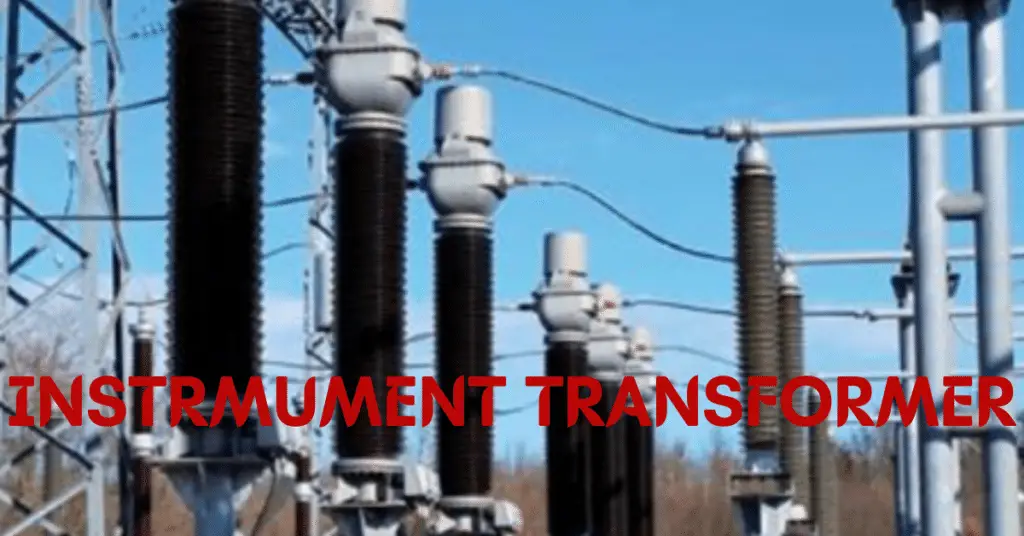This article describes the major differences between an instrument transformer and a power transformer. A transformer is electrical equipment used for stepping up or stepping down the voltage level. The transformer does not change the power and frequency. Both these parameters remain unchanged when the transformer steps up or step-down the voltage.
A transformer has a magnetic core on which two winding called primary winding and secondary winding are wound. level of voltage or current to a desired value. These two windings are electrically isolated from each other but magnetically coupled.
When we feed the AC supply in the primary winding, it generates changing magnetic flux. The magnetic flux travels through the magnetic core and is coupled to primary as well as secondary winding. The varying magnetic flux coupled to the primary winding and secondary winding induces EMF. The EMF induced in the secondary depends on the turn ratio of the transformer.
The following types of transformers are widely used as per the application requirements.
- Power transformer
- Distribution transformer
- Instrument Transformer

Let us first discuss what is a power transformer and instrument transformer.
What is a Power Transformer?
Power transformers are basically large-rating transformers used in high-voltage applications. They are generally installed at the generating station to increase the voltage for onward transmission of electric power at high voltage over a long distance. At the receiving end. the power transformer reduces the voltage as per the user’s requirement.

Therefore, on the basis of raising/lowering voltage, the power transformer is of two types. The step-up power transformer raises the voltage, while a step-down power transformer lowers the voltage. The power transformers are generally delta-connected primary and secondary winding, because, in power transmission at high voltage, the neutral is not required.
What is an Instrument Transformer?
As its name implies, the instrument transformer is connected to measuring or protection equipment. The instrument transformer is used to measure the electrical quantiles like current and voltage. The direct measurement of electrical quantities on high voltage by conventional instruments such as an ammeter, and a voltmeter is not possible and, we need to install a current transformer and a potential transformer to lower the current and voltage respectively.

The current transformer reduces the current of a transmission line to a measurable value. We can also call it a step-up transformer because it increases the voltage in the secondary proportionally to the decrease in the current. The secondary of the current transformer must not be left open-circuited because the high voltage at the secondary can cause damage to CT. The CT secondary must be always a closed circuit.
A potential transformer is an instrument transformer that lowers the line voltage to a measurable value. The potential transformer is a step-down transformer, it has more turns in its primary and fewer turns in its secondary. The turn ratio of the potential transformer(N1/N2) is more than 1.
Difference between Power Transformer and Instrument Transformer
The key differences between a power transformer and an instrument transformer is listed in the below table.
| Basis of Difference | Power Transformer | Instrument Transformer |
|---|---|---|
| Description | A power transformer is one which has a high kVA rating and is used for changing the voltage level for power transmission. | An instrument transformer is one that is designed to reduce the level of either voltage or current of a transmission line for measurement and protection purposes. |
| Purpose | Power transformers are primarily used for changing the line voltage levels in a power system. | Instrument transformers are primarily used to extend the ranges of measuring devices so that they can measure high voltage, current, power, etc. |
| Power handling capacity | Power transformers can handle a large amount of power. | Instrument transformers can handle very small power. |
| Function | Power transformers increase or reduce the line voltage of transmission lines. | Instrument transformers reduce either voltage or current to a safer and measurable value to supply it to devices like ammeters, voltmeters, protective relays, etc. |
| Heating | As the power transformer handles a huge amount of power, hence the heat produced is more. | In instrument transformers, the heat produced is quite less. |
| Need of cooling | The heat produced in the power transformers is more. Therefore, they require extra cooling arrangements. | The heating in the instrument transformers is not severe. Thus, natural cooling is sufficient. |
| Conservator tank | The conservator tank is a crucial part of a power transformer. | An Instrument transformer does not have a conservator tank. |
| Load limitation factor | In the case of the power transformers, the temperature rise is the main limiting factor on the load. | In instrument transformers, accuracy is the primary limiting factor on the load. |
| Design consideration | For power transformers, cost, efficiency, and voltage regulation are the main design considerations. | Accuracy and cost are the main design considerations for the instrument transformers. |
| Cost | The cost of power transformers is very high. | Instrument transformers are quite cheaper than power transformers. |
| Examples | Examples of power transformers are: generating station transformers, receiving station transformers, substation transformers, etc. | Current transformers and potential transformers are the two major examples of instrument transformers. |
Conclusion
In the above table, we have highlighted all the major differences between a power transformer and an instrument transformer. Both types of transformers are necessarily used in every power system installation.